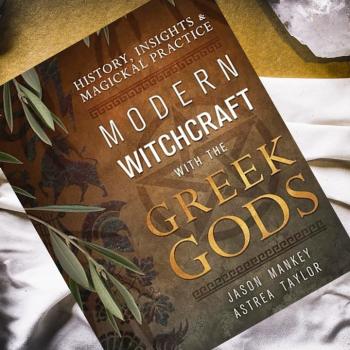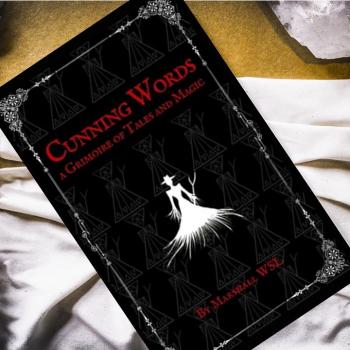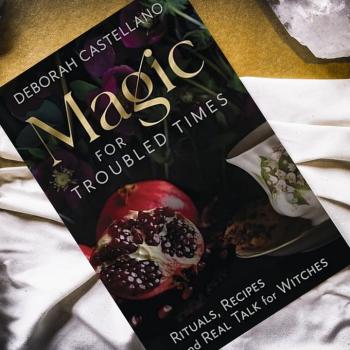Family Coven is a group of persons who share shelter, food and resources for the purpose of survival while acknowledging the spiritual nature of the human condition. The term is a deliberate joining and redefinition of the terms ‘family’ and ‘coven.’
When I discuss family, it is important that any reader understands thatmy definition of family includes a broad spectrum of shapes, sizes and types of family units. Currently my family coven, Dragonstone Family Coven (DSFC), is comprised of myself and my husband, Tony; my fifteen-year-old, Sam; and Nathaniel, a twenty-seven-year-old recovering from a vicious motorcycle accident. Nathaniel has become my half-brother in name and function (brother from another earthly mother sharing spiritual parents in the Lord and Lady). He will be with us for the bulk of his recovery, which is just fine by us.
Although my family make-up is a traditional one, with a male and female as a mom and dad, we are a blended home: Sam’s biological father is a witch who resides in another state with his wife, who is also a witch (no, really, she is Streggan and everything). This make up was born more out of who I happened to have fallen in love with (Tony) than any conscious decision to have my family defined by traditional standards. Sam has been raised in a home where the male form and the female form are seen as equally divine, sexy and sacred. Our family members are as likely to say “What a hot woman,” as we are to say “What a hot man!” We encourage Sam to love the person, not the form the person takes, and Nathaniel fits well into our home as an openly bisexual single man.
During the preparation for my book Family Coven: Birthing Hereditary Witchcraft (Immanion Press, 2014), I was honored to work with polyamorous family units, gay family units, lesbian family units, single head of household family units (both male and female run), family units with and without children, and even single persons who developed their idea for Family Coven by setting their intent and desire as they sought a mate or mates.
I do not think that it is possible for any family unit to be without both male and female energies. Sometimes that energy is presented in physical manifestations that reflect the energy raised, though at other times, the physical manifestation (upon brief visual inspection) seems to contradict the idea that both female and male energies are present. But I do not believe that the energy of maleness and femaleness are defined by the physical form a body takes. They are created within the heart, mind and makeup of the person who raises that energy.
Beyond my belief that physical form does not always define the energetic output created for family coven, I do not think that defining marriage as a partnership between only two people is an accurate reflection of Family Coven. One family unit featured in my book is comprised of a single mother and her two male partners. Their many children were fathered by one of these men, and there has been no delineation for the children about whose child is whose. It is irrelevant. The children are the Family Coven’s, and that is of paramount importance.
Of course, blended families abound in my research regarding Family Coven. However, Family Coven does not only concern itself with the physical make-up of the family unit. Family Coven wonders about the spiritual paths that are held by individuals in the family unit.
In my research, I have had the honor of working with families where all partner(s) are involved in The Craft; one partner was Craft and the other partner Russian Orthodox; one family member agnostic in a family of Wiccans; one member Christian, two members pagan, one member Buddhist. One of the unique things about Family Coven is that by definition, family coveners are concerned with supporting, promoting and facilitating the spiritual paths that manifest within the Family Coven. Those spiritual paths are not defined by anyone but the individual who walks the path. When children are involved, the spiritual leaders of the Family Coven, typically all elders who are living with the children, set out to expose the children to as many different spiritual experiences and paths as possible. My son has been to Buddhist, Evangelical Christian, Catholic, Wiccan, Druid, Pagan, Heathen, Southern Baptist, Methodist, Presbyterian, Greek Orthodox, Hindu, Jewish and Episcopalian services, events, temples and holy day celebrations. As his interests have changed, so has the focus of his exposure. During his Buddhist days he was taken to Buddhist temples, taught meditative techniques and provided with age-appropriate Buddhist teachings. When he turned toward the Nordic path in his pre-teen years, the appropriate books and stories were taught. Now that he has turned to Gnostic teachings and has begun to show an interest in the Catholic Church. Discussion around those beliefs and teachings has been provided, including a rosary with information on how to correctly use it to pray.
Despite Sam living in a house filled to the brim with Wiccan Pagans (Nathan, Tony and I all identify as Wiccan/Pagan), Sam is given plenty of room, advice and guidance regarding whatever spiritual path he shows an interest in. He is assured that he is young and still developing; he may not know what he believes or how he wants to worship until much later in life, and that is all right. All the elders in my home have shared with Sam how we came to our paths, and he has sat in on classes and other discussions about religion when we have them.
All this talk of child rearing, however, should not convince the reader that children are required for Family Coven. Note in my opening definition that the reason for shared resources is survival, not the raising of children. This means that persons who are not yet partnered and partner(s) without children can take advantage of the idea of Family Coven too. A hereditary path can be created, maintained, and passed on to whomever may come into the knowledge in the future. We all are legacy creators. The legacy we will leave is in our spiritual knowledge, our mundane experiences, and the things we have found sacred. When that information is preserved, hereditary witchcraft is born.
Notably missing in Family Coven is a dogma of practice. This is a cornerstone of Family Coven belief, and it is in contrast to traditional covens and groups, where (often, but not always) how a circle is cast, how the quarters and watch towers are called, how the divine energies are evoked or invoked, how energy raising is done, and how the aforementioned are released are all strictly defined. This dogma of practice may ultimately interfere with the idea of individual path development.
My pagan friend and his Russian Orthodox partner are the best examples I have for this ideology. Without a flexible spiritual practice, one partner might put forth an ideology that attempts to outshine or manipulate the spiritual path of the other partner. The results of this type of power struggle can be terminal. Dogma of practice is often upheld by a dogma of belief. If my dear friend’s wife were less tolerant, then his pagan beliefs may be seen as a threat to her beliefs. Her assertion of a dogma of belief and practice could be used to insist that her path is right and therefore justified.
In order to release oneself from a dogma of practice, dogma of belief must be released first. An understanding that there is not one true and right path up the mountain of spiritual enlightenment is imperative. I often think that people are threatened by the beliefs of others because they are secretly wondering if someone else’s belief will invalidate their own tenuously held philosophies. In Family Coven, a concerted effort is made to allow the manifestation of spiritual belief to occur naturally for each individual family covener.
The concern that can arise when you release the idea of only ONE true path to enlightenment and spiritual development is the dreaded idea that “All paths are sacred.”
I absolutely loathe this statement. Not all paths are sacred. I know this because it is an allegedly sacred path that led to the destruction of the Twin Towers and a portion of the Pentagon. It is in the name of sacredly held beliefs that bombings occur throughout the Middle East, war is waged in Palestine and Israel, and years of social and political strife continue in Northern Ireland. Sacredness is not singularly defined by the seeking of a spiritual path. I firmly believe that many persons hold a misguided belief about the sacredness of their path, when in actuality they are utilizing a spiritual dogma to justify acts of aggression, enslavement and strife.
As my friend Rev. Kyler recently told me, “That is not their sacred path. That is their psychological damage.”
Within Family Coven, people have choices to make regarding paths that bring divine enlightenment and paths that bring destruction to self and others. The way a family covener delineates what type of spiritual path they are on is by reflecting on the Family Coven Virtues. These virtues are as many as the Family Coven decides and should be the cornerstone for all behavior within Family Coven.
For example, a Family Coven may decide that strapping a bomb to oneself to prove the potency of their belief and the might of the Divine being they worship is outside the Family Coven virtues of tolerance, kindness, respect, reverence and/or discernment. These virtues allow for those gray areas that many pagans and heathens walk, away from the dogma of the Ten Commandments and toward a more realistic view of the world and society. This approach requires a discussion of ethics and morals rather than a belief that one must simply obey the celestial edicts of some ancient god or goddess. It is a way to fairly hold all members accountable for behavior without the notion that a person is “bad.” It is a person’s actions that a Family Coven is concerned with.
As this column moves forward, I may meander back to these different ideas dependent upon what comes up in the news, and I may stray from these building blocks to explore anything from training materials for children to holistic first aid kits. I may delve into interpersonal relationships and communication or look into the sexual development of persons within pagan belief. As I do this, the virtues of my Family Coven will guide my discussions. These virtues are my compass, my North Star, and they are the expectations to which we hold all of our Family Coveners.
Birthing Hereditary Witchcraft is published on alternate Mondays. Subscribe via RSS or e-mail!












